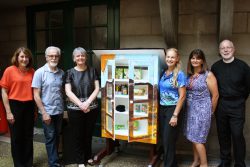 The Anglicare SQ ‘Precinct Pantry’ is a continuing focal point for staff food donations for people ‘sleeping rough’ in the Cathedral grounds, and for the Holy Trinity Parish, Fortitude Valley, Emergency Relief Pantry.
The Anglicare SQ ‘Precinct Pantry’ is a continuing focal point for staff food donations for people ‘sleeping rough’ in the Cathedral grounds, and for the Holy Trinity Parish, Fortitude Valley, Emergency Relief Pantry.
The pantry was launched in Anti-Poverty Week 2018. It was designed, made and decorated by young people at the Brisbane Youth Detention Centre.
Approximately 100 staff and guest gathered to celebrate the installation of the pantry in the Webber House courtyard in Ann St, Brisbane.
BYDC school principal, Kathy Morrison, and Chaplain, Leisa Logan, presented the pantry on behalf of the young people.
Kathy said the design was a particular focus of interest for the young people.
 “An Australian country scene got the final vote.
“An Australian country scene got the final vote.
“The original design concept of painting Australian animals on the pantry was overruled because some young people thought that could put off vegetarians, and people could be frightened of snakes.”
As then construction teacher, Nic Howe, said, “The project definitely fired up the imagination of some of our young people, and their teacher as well!”
The project is part of a Certificate program in construction run through the detention centre, which makes and donates a range of items to the community, including dog kennels donated to the RSPCA, outdoor seating and cubby houses.

Being hungry in Queensland
Hunger is largely a hidden social problem and many people suffer in silence.
But each year 400,000 Queenslanders experience food insecurity – around half of them are children. That’s one in every ten people.
Anglicare’s 2012 research into food insecurity showed some of the pressures that come from not knowing whether you’ll have enough to eat. Queenslanders shared the following comments:
I stress and get depressed.
It affects your health, your attitude to others, your state of mind.
The last thing I want is for my children to go without food. I feel depressed/down, and keep to myself.
The hunger-relief organisation, Foodbank, says being employed is not always a safeguard. Almost half of those experiencing food insecurity (48%) are employed – full-time, part-time, casually or self employed – and still find it hard to keep food on the table.
More information about poverty and food insecurity
Australian poverty in graphs: it’s a desperate state of affairs (Greg Jericho, The Guardian, 16 April 2019)
To have and to have not: Measuring child deprivation and opportunity in Australia (ARACY, 2019)
Poverty in Australia 2018 (ACOSS)
Inequality in Australia 2018 (ACOSS)
The Foodbank Hunger Report 2017 (Foodbank)
When there’s not enough to eat (Anglicare Australia State of the Family Report 2012)
Return to Advocacy Home Page




